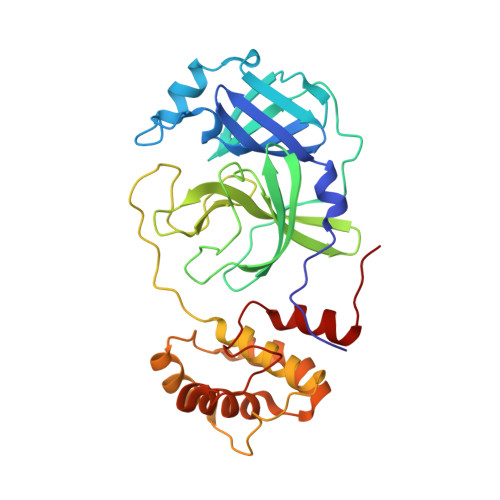SARS-CoV-2 M pro Protease Variants of Concern Display Altered Viral Substrate and Cell Host Target Galectin-8 Processing but Retain Sensitivity toward Antivirals.
Chen, S.A., Arutyunova, E., Lu, J., Khan, M.B., Rut, W., Zmudzinski, M., Shahbaz, S., Iyyathurai, J., Moussa, E.W., Turner, Z., Bai, B., Lamer, T., Nieman, J.A., Vederas, J.C., Julien, O., Drag, M., Elahi, S., Young, H.S., Lemieux, M.J.(2023) ACS Cent Sci 9: 696-708
- PubMed: 37122453
- DOI: https://doi.org/10.1021/acscentsci.3c00054
- Primary Citation of Related Structures:
8DI3, 8DJJ, 8DK8, 8DKH, 8DKJ, 8DKK, 8DKL, 8DKZ, 8DMN, 8EJ7, 8EJ9 - PubMed Abstract:
The main protease of SARS-CoV-2 (M pro ) is the most promising drug target against coronaviruses due to its essential role in virus replication. With newly emerging variants there is a concern that mutations in M pro may alter the structural and functional properties of protease and subsequently the potency of existing and potential antivirals. We explored the effect of 31 mutations belonging to 5 variants of concern (VOCs) on catalytic parameters and substrate specificity, which revealed changes in substrate binding and the rate of cleavage of a viral peptide. Crystal structures of 11 M pro mutants provided structural insight into their altered functionality. Additionally, we show M pro mutations influence proteolysis of an immunomodulatory host protein Galectin-8 (Gal-8) and a subsequent significant decrease in cytokine secretion, providing evidence for alterations in the escape of host-antiviral mechanisms. Accordingly, mutations associated with the Gamma VOC and highly virulent Delta VOC resulted in a significant increase in Gal-8 cleavage. Importantly, IC50s of nirmatrelvir (Pfizer) and our irreversible inhibitor AVI-8053 demonstrated no changes in potency for both drugs for all mutants, suggesting M pro will remain a high-priority antiviral drug candidate as SARS-CoV-2 evolves.
- Department of Biochemistry, University of Alberta, Edmonton, Alberta T6G 2H7, Canada.
Organizational Affiliation:
















